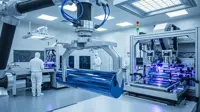Companies that invest in Robotic Process Automation (RPA) or Artificial Intelligence (AI) see much higher performance returns, especially if they also invest in people. In fact, the very presence of automation in the workplace is making work environments ‘more human’, states The Augmented Human Enterprise – a major academic study conducted by Goldsmiths, University of London, and research commissioned by Automation Anywhere, a leading enterprise software provider.
India driving RPA adoption worldwide:
Of all those surveyed, 71 per cent of Indian respondents said that their employees used RPA and AI-based augmentation to its full potential, the highest proportion for any of the four markets surveyed.
While 66 per cent of Indian respondents said that they are empowered to take risks, 77 per cent said that their organisation prioritised employee development; in both cases, the highest percentage of positive responses for any of the four markets was found in the country. India also outscores other markets on employee engagement and (with an impressive 84 per cent) on employee listening.
Automation and AI are making work more human
“Think of the human body breathing,” says Mihir Shukla, CEO at Automation Anywhere. “It’s a complex and critical mechanism, but automated, so our brains are freed to power everything else we do. I think for many organisations, all they can do is ‘breathe.’ It’s so important, it’s all the employees can focus on. But when that breathing is automated within the organisation, then employees can focus on so many creative and strategic issues and opportunities. It’s perhaps why this unique research shows that augmented organisations outperform non-augmented enterprises and have more ‘human’ workplaces.”
The research methodology included:
- Surveying senior business leaders from major enterprises in India, UK, US and Japan
- A comprehensive review of academic literature and research findings into the impact of automation at the workplace
- Interviews with leading automation and AI subject-matter experts, including technologists, CEOs, scientists and engineers
The research team questioned business leaders on the extent to which they are humanising their workplace to help people meet their full potential. They later looked at whether the arrival of automation technology – specifically RPA and AI – is having a positive or negative effect on this human experience.
The researchers found that in global augmented workplaces:
- Workers are 38 per cent more engaged than those in non-augmented workplaces
- 70 per cent of respondents said augmentation had improved the well-being of their team
- 80 per cent of those using AI and 78 per cent using RPA said it frees employees from repetitive work
“Digital technology’s nascent autonomy promises an evolutionary leap in our capacity to grow as human beings,” says Dr Chris Brauer, Director of Innovation in the Institute of Management Studies (IMS) at Goldsmiths, University of London.
“While the hyped potential of AI generates endless headlines, technologies such as RPA are quietly being rolled out in many of the most productive companies around the world – humans and bots are already working alongside each other across the globe and in every sector. Where businesses are getting it right, the best of our human capabilities are being augmented by technology to create innovation previously unimagined. But in these early days, not everyone is getting it right.”
The research delves into understanding how automation makes people happier at work. It frees them from repetitive tasks to concentrate on creative and strategic work – the bits of their job they enjoy most. But the research also warns that this doesn’t happen by itself. The research highlights that automation must be used to enhance employee skills and complement their working styles to derive the maximum benefit.
Investment in automation technology alone results in some improvements in business performance. But investing simultaneously in people — by creating a human workplace — supercharges the performance boost that companies can expect to gain from the technology investment. The research found that global augmented organizations:
- Achieve 28% higher overall performance
- Have 31% better financial performance
- Are 30% more likely to prioritize strategic goals
Firms investing in people alongside the technology see better outcomes across three different dimensions of performance, including financial returns, innovation and cultural performance. Unsurprisingly, with such a positive rate of acceptance by organizations, India leads the way in reaping the benefits of augmentation, with 86% of the respondents saying that automation has increased employee productivity.






















